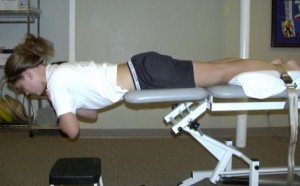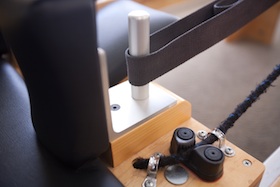At the September 2005 Western Occupational Health Conference, Physical Therapy of Los Gatos principal Rob Naber delivered presentations on anterior knee pain and lumbar active range of motion. At the same conference, Rob also gave a somewhat more technical presentation for physicians on the topic of lumbar spine stability. This web site article was adapted from his presentation notes and materials.
Lumbar spine stability is an important concept in orthopedic medicine because its absence is often identified as the cause of lower back pain. When the lumbar spine is insufficiently stable, the motion between the joints of the lower back is exaggerated and abnormal. A patient with lumbar spine instability will experience lower back pain when the joints of the lumbar spine “wobble” in use rather than transferring forces with the smooth, synchronous movements of a healthy spine.
If lumbar spine instability is identified as the cause in a case of lower back pain, lumbar spine stabilization must be the cure. Too often this simplistic view of the relationship between lumbar spine stability and lower back pain is used as the basis for handing out “core strengthening” exercise instructions as a treatment for lower back pain. Few cases of lower back pain caused by lumbar spine instability are relieved by pre-printed handouts of abdominal and paraspinal, or “core,” strengthening exercises.
While we encourage our patients toward any healthy form of exercise, including those forms that address core strength, we are critical of physical therapists and other health care providers who prescribe pre-printed, generic strengthening exercises to patients suffering from lower back pain. In most cases, these exercises will fail to provide any relief. And unfortunately, the most motivated patients receiving these instructions will succeed in strengthening their abdominal and paraspinal muscles. Greater strength will cause untreated lumbar spine joint wobbling to occur with greater force and velocity, and the patient will feel much worse.
In the maintenance of healthy lumbar spine stability, muscle endurance is more important than muscle strength. Furthermore, muscle endurance, the condition of ligaments, and motor control of the structures supporting the spine must be in balance if lumbar spine stability is to be achieved. Generic muscle strengthening regimes that disregard initial measures of paraspinal and abdominal wall muscle endurance, and do not aim to restore correct, specific, balanced, and sustainable force vector ratios around the lumbar spine will fail to produce measurable improvements and will likely increase the patient’s pain and disability.
 At Physical Therapy of Los Gatos, our physical therapists are trained to evaluate lumbar spine instability using effective methods and clinical precision. Measurements taken during the evaluation phase of therapy and at key intervals over the course of treatment include timed isometric holding exercises in right and left “side plank” positions, a sixty degree sit-up position, and the Biering-Sorensen position (pictured). The results of these tests are compared with normative time values determined in research studies and are used to design individualized treatment protocols to restore correct force vector ratios around the lumbar spine. These individualized treatment protocols produce complete and rapid recoveries from lower back pain caused by lumbar instability.
At Physical Therapy of Los Gatos, our physical therapists are trained to evaluate lumbar spine instability using effective methods and clinical precision. Measurements taken during the evaluation phase of therapy and at key intervals over the course of treatment include timed isometric holding exercises in right and left “side plank” positions, a sixty degree sit-up position, and the Biering-Sorensen position (pictured). The results of these tests are compared with normative time values determined in research studies and are used to design individualized treatment protocols to restore correct force vector ratios around the lumbar spine. These individualized treatment protocols produce complete and rapid recoveries from lower back pain caused by lumbar instability.
Lumbar Spine Stabilization presentation by Rob Naber to the 2005 Western Occupational Health Conference (765 KB .pdf
Conference Program Abstract (76 KB .pdf download)

Comments on this entry are closed.